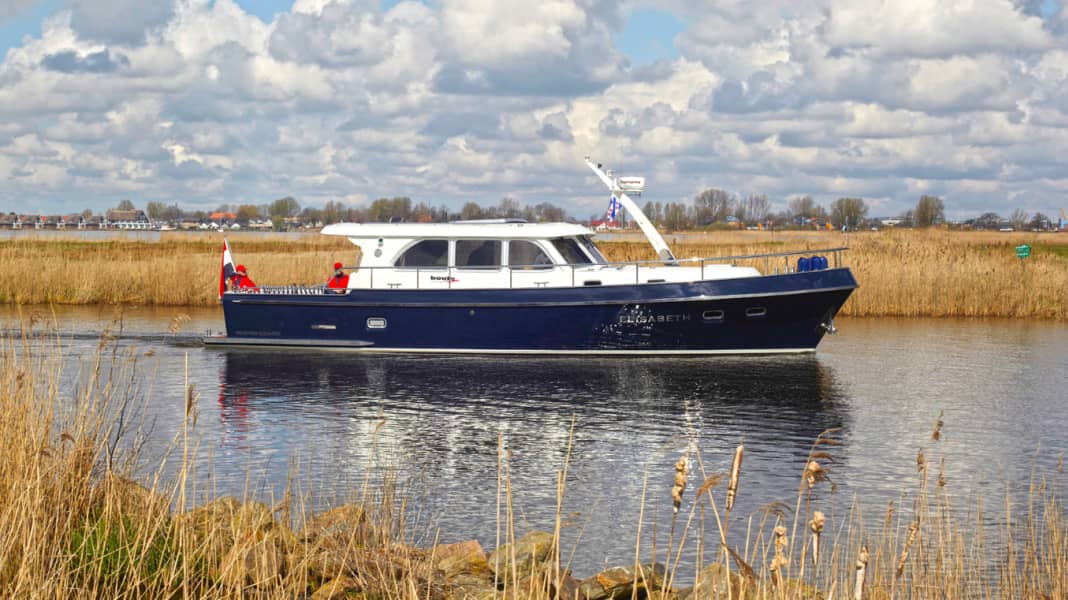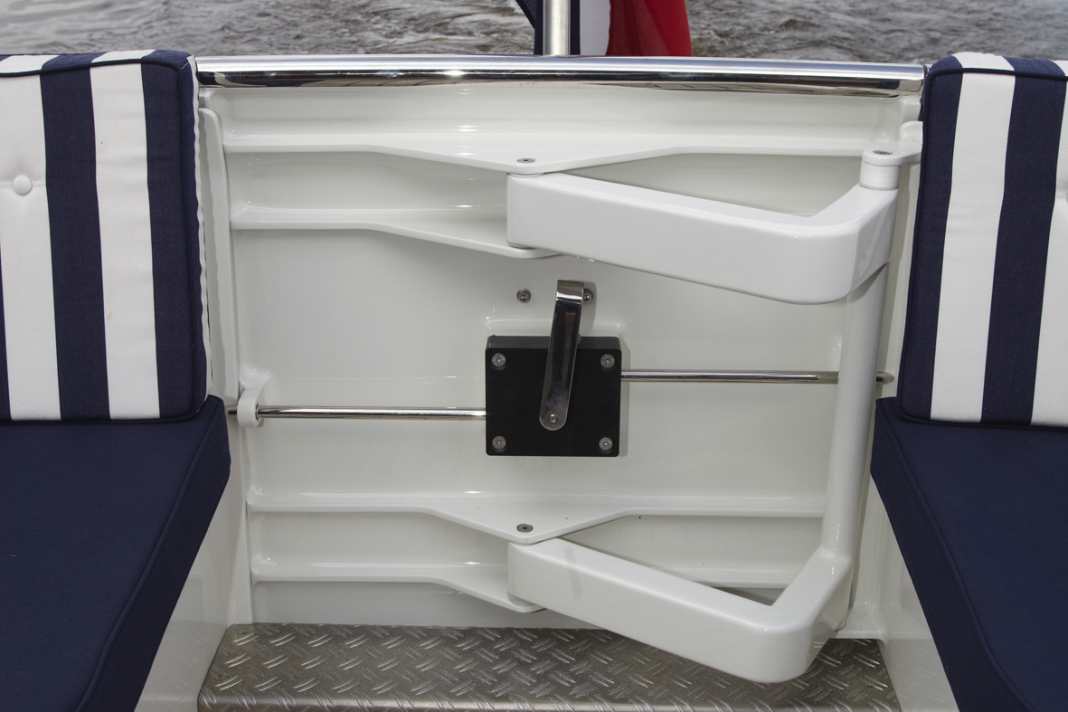

Cabin manufacturers usually fit at least two sleeping cabins into a boat over 13 metres long. Not so on our test boat, the Privateer Elegance 43, which was designed by the Dutch boat builders together with the owner for a comfortable life for two.
For this purpose, the shipyard has installed a cabin in the bow only, in which there is a large, comfortable double berth with perfectly ventilated (slatted) cushions. To make it easier to crawl into the bunk, there are steps next to the bunk. Further amenities: The storage compartment flap under the bed is fitted with gas dampers for easy operation, and there is a drawer in the front area that is easily accessible from the footwell. Small items can be stored on the shelves and clothes in the two lockers with grab rails.






Ventilation is provided via portholes and ceiling hatches. If that's not enough on warm days, you can order air conditioning for an extra charge. To summarise the cabin: not huge, but very practically arranged and equipped. A well-ventilated toilet room to starboard and a shower to port, both generously sized and comfortably equipped, are installed in front of the forward cabin. The headroom ranges from 1.93 m to 1.96 m. One floor up in the saloon, the distance between floor and ceiling is over 2.00 metres. There you will find a U-shaped seating area with a table that can be converted into a bunk, for example to allow children to stay overnight or to serve as "emergency accommodation" for a guest.
The firmness of the upholstery gets good marks, which also applies to the equipment and layout of the galley on the opposite side. Here, the cook is right in the centre of the action. Privateer installed a 5 kW inverter on our test boat so that he can also indulge in his passion at the anchorage on the ceramic hob (extra) and microwave. The best thing about the anchorage, however, is undoubtedly the view from the saloon. The large windows in the front, sides and rear are responsible for the unrestricted all-round view. In short: ideal for sitting, watching, chatting and eating.
If you want to do the latter in the open air, head into the spacious cockpit to the split U-shaped bench seat with free-standing table. Additional seating options can be realised at any time with additional furniture. There is a bimini cover for the cockpit to protect you from strong sunlight or light rain.
Bathing enthusiasts will find their place on the sufficiently large bathing platform, which can be easily accessed via a sturdy bulkhead door between the stern bench. The standard 4-step niro ladder can also be easily operated from the water, and if you want to take a quick shower after bathing, you can do so at the stern shower (hot/cold).
Driving and manoeuvring
As is usual with the sedan versions, the boat is driven from the saloon. The driving position on our test boat is on the port side and offers a comfortable driver's seat with armrest and adjustment options forwards and backwards. If you want to put your feet on the footrest board provided, you either have to spread your knees or push the driver's seat far back. However, the latter is always a compromise between the distance to the steering wheel and legroom.
The co-driver on a well-padded double bench to starboard, which is big enough for two people, has it better in this respect. However, only the edges of the furniture are suitable for holding on to. To ensure that the driver always has a good view even on rainy days, Privateer has installed three double-arm windscreen wipers (with washer system) on the split windscreen (thermal glass). The view of the instruments is practical, and the angled Raymarine chart plotter is particularly easy to read when sitting or standing.
He showed the Heegermeer in Holland as a test area. This is an ideal area for hiking with the Privateer. If you want to do this at creep speed, you can let the Vetus diesel run at around 1000 rpm and move through the water at a leisurely 4.5 knots. The range with 600 litres of fuel is almost 1000 nm minus 15%. The shipyard states a cruising speed of 7.5 kn, which according to our measurements corresponds to a good 2000 rpm. In this situation, the range is an acceptable 250 nm. At full throttle, we recorded a theoretical range of a good 150 nm at a maximum speed of 8.4 knots. This would increase slightly in deeper waters, as a water depth of only around three metres on the test area has a negative effect on the speed and the hull is virtually slowed down.
To maintain the course once you have set it, you have to allow the hull to stabilise briefly and only counter-steer a little - if at all. The rudder angle indicator is good in this respect, allowing you to quickly find the "new centre" after a turn. This display is integrated into the self-steering system, which replaces the helmsman on lakes (or at sea) if necessary. To ensure that the journey is also comfortable for the ears, the shipyard has carefully fitted the engine compartment with sound insulation that effectively muffles the sound of the engine (maximum 69 dB/A).
Further convenience and safety are guaranteed by the installed bow and stern thrusters. These and the smooth-running rudder (hydraulic) are used to steer the Privateer precisely into the box, onto the jetty or against the lock wall.
The hull acknowledges fast turns of around 1 ½ boat lengths in diameter with a slight lean on the outside of the turn and a soft turn into its own wave. The only drawback: when steering out, you have to apply force for the first few centimetres to turn the steering wheel. - The rough water test was cancelled due to the lack of waves.
Engine, tank, electrics
The Vetus diesel engine, which stands firmly on steel foundations, can be accessed via a hatch in the saloon with two gas dampers. In the hatch area, the service technician has plenty of space for maintenance work, while on the port side he has to make do with around 0.70 metres of headroom. The technicians laid the cables and hoses neatly and securely. Further praise goes to the diesel lines made of copper pipe, shut-off valve (remote-controlled), double diesel cleaning system with filter cartridges and drain cock.
To ensure that the power does not run out so quickly without a shore connection, the shipyard installs plenty of starter, thruster and on-board batteries and (on our test boat) a 3.5 kW whisper generator (extra). The consumers are controlled via a bus system that is activated by pushbuttons. In some cases, the main switches of the on-board electrical system can also be operated via this. Otherwise, the tried-and-tested manual main switches are still located in the engine compartment.
The fact that Privateer offers a high level of safety can be seen not only in the sturdy railing and the non-slip bar deck, but also in the equipment with three electric and one manual bilge pump as well as two fire extinguishers and a fire extinguishing system in the engine compartment. First-class craftsmanship can be found throughout the boat. This begins with the expertly welded seams and paintwork, continues with the polished railing and rubbing strake and ends with the fittings with precise gap dimensions.
Conclusion: The Privateer Elegance 43 is a perfect boat for two people who appreciate peace and comfort. The moderate clearance height is ideal for inland areas; however, the range and CE category B also allow you to go out to sea, for example to the island of Bornholm.
Data sheet: Privateer Elegance 43
Shipyard: Privateer
Type designation: Privateer Elegance 43
CE category: B - Outside coastal waters
Material of hull and deck: Steel
Length: 13,10 m
Width: 4,20 m
Displacement: 16,50 t
Price: 571.200,00 €

